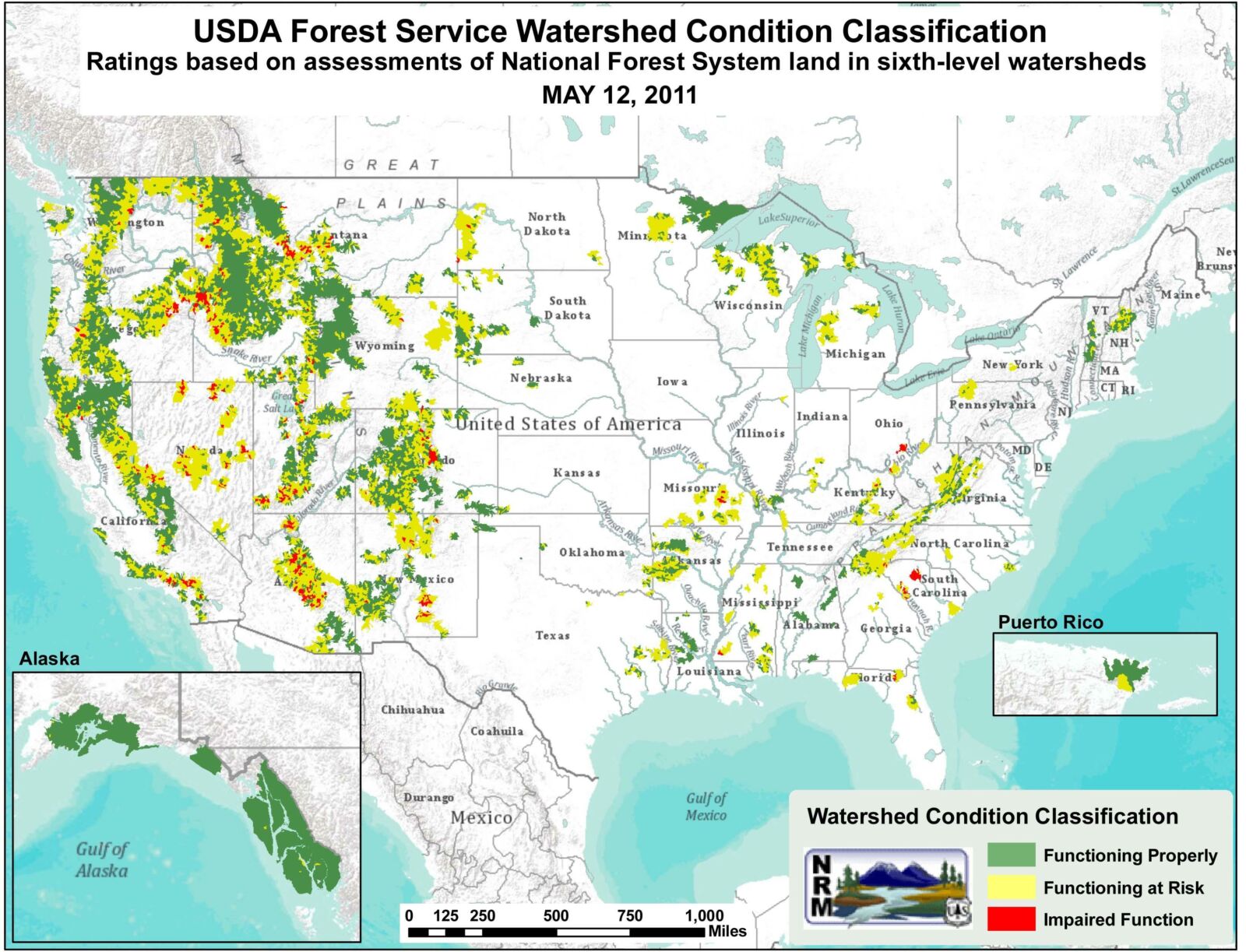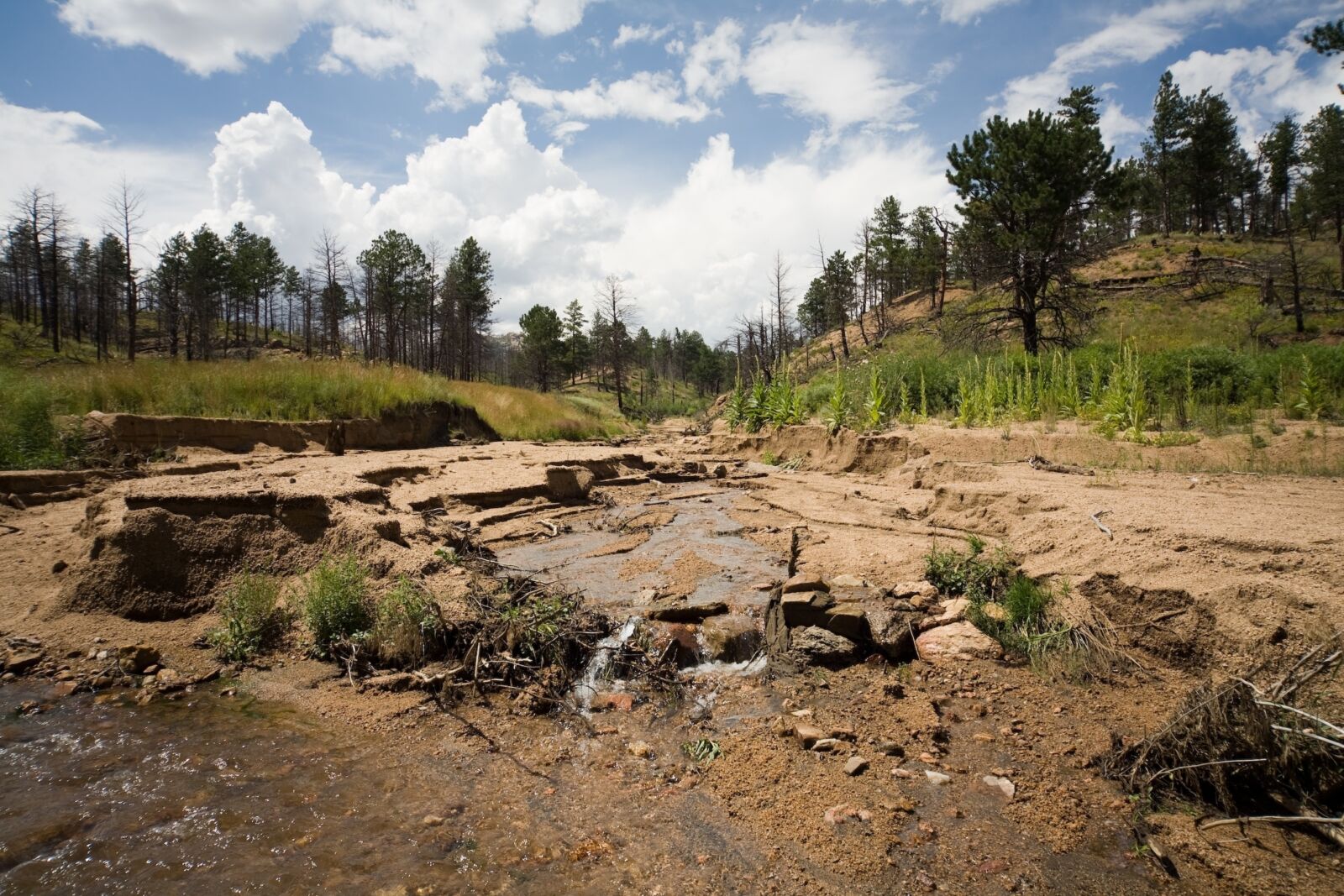Especially if you live in the western United States, there’s a good chance that water came from a National Forest. Although our National Forest System was originally established “for the purpose of securing favorable conditions of water flows, and to furnish a continuous supply of timber,” we often forget that National Forests are the headwaters of America. In fact, National Forests supply approximately 20 percent of Americans with a reliable supply of cold, clean water.
But what exactly do forests have to do with water? Forested lands capture and hold snow in the winter. Forest soils absorb rain and snow like enormous sponges, acting as a natural filter, replenishing underground aquifers, and slowing down high water flows as the water moves downhill. In addition to providing water for human use, water flowing from National Forests supports valuable ecological communities—wetlands, meadows, lakes, and streams.
These watershed services and the natural and human communities that they support are of incalculable value to the American public. If you’ve spent time camping next to a creek or fishing at your favorite river, you understand that our forested watersheds are fundamental to our national identity and are a valuable legacy that we must pass on to future generations. These values extend beyond our own memories and experiences.
A recent U.S. Forest Service study conservatively estimated the value of watershed services from National Forests and Grasslands at $3.7 billion annually. And the best part? Healthy National Forests and Grasslands will continue to supply these valuable services…if we take care of them.
Increasing Threats
While National Forests and Grasslands are the single largest supplier of water in the United States, a number of factors have left many watersheds degraded and in need of restoration. Severe wildfire and climate change rank as the two main threats to the watersheds on our National Forests.
A recent U.S. Forest Service report stated that climate change has, and will continue to affect the quality, quantity and timing of stream flows from forests.
While natural fire plays an important role in many forests, the dense and overcrowded conditions that have become typical of many of our National Forests have left them vulnerable to a startling new trend—severe landscape-scale fires. We saw this in the news this summer: As of October 2012, nearly 9 million acres had burned, and experts estimate future fire seasons of up to 12 million acres. These abnormally large and severe wildfires negatively impact our watersheds by burning vegetation that would normally absorb runoff and hold soil in place. The resulting flush of water and sediment clogs reservoirs and requires expensive dredging and repairs. The costs of these fires extend well beyond the suppression efforts of fire fighters. These costs are already excessive for western communities dependent on National Forest watersheds for their drinking water supplies, and forcing others to assess their risks.
For example, sediment removal costs in one of Denver’s municipal watersheds following a severe wildfire amounted to more than $40 million. The City of Santa Fe estimates that a relatively small 7,000-acre fire on the National Forest lands within its watershed would cost approximately $22 million in reservoir dredging costs to restore a functioning water supply for the city’s residents.
A recent U.S. Forest Service report stated that climate change has, and will continue to affect the quality, quantity and timing of stream flows from forests. This warming trend is already documented, with average temperatures predicted to increase by 2°C by as soon as the middle of this century.
So what can we expect for our National Forests? We can expect warmer winters with more precipitation falling as rain rather than snow—running off faster and earlier, leaving less water for late-season stream flows. In the summer we can expect hotter temperatures, warmer streams (troublesome for fish), and more forests stressed by severe drought. In addition to these direct impacts to our water supply, we can expect to see a further decline in forest health, more beetle-related death, and more severe wildfires.
Investing in Healthy Headwaters
In an era of bigger fires and a changing climate, the U.S. Forest Service and the American public are slowly realizing the urgency of investing in healthy and resilient headwaters. U.S. Forest Service Chief Tom Tidwell recently emphasized watershed restoration and stewardship as a core agency goal, when he stated, “Ultimately, our success at the Forest Service will be measured in terms of watershed health on those 193 million acres of National Forests and Grasslands.”
The recently released Watershed Condition Framework (WCF) reflects the U.S. Forest Service’s commitment to restoring key watersheds. The WCF assesses watershed conditions on individual National Forests and prioritizes key watersheds for comprehensive restoration projects. In addition to providing a “roadmap” for bringing our watersheds back into shape, the WCF features an interactive map showing the condition of our National Forest watersheds.

The Forest Service Watershed Condition Framework ranks the currently health of forest watersheds.
With nearly half of watersheds on National Forests classified as “Functioning at Risk” or “Impaired Function” through this framework, the challenge to restore America’s headwaters is immense. Some estimate that, even with aggressive watershed restoration and improvement activities, we may not see the results of our efforts for many decades. With this in mind, the U.S. Forest Service has strategically focused on watersheds where there is hope of making a significant difference.
Although repairing our headwaters is a priority of the U.S. Forest Service, the agency cannot meet its ambitious goals without substantial financial resources. National Forest management funding is limited; about two-thirds is spent on responding to large fires. With limited funds left for preventive actions and watershed restoration, it will take more than the U.S. Forest Service’s declining budget to restore our imperiled watersheds.
Where to look for help? With today’s poor watershed conditions and current levels of funding, more attention is being directed toward downstream water users, who currently receive large benefits from upstream watersheds that collect, store, purify and deliver usable water to them at little or no cost. Many feel it is time to assign a price to the many watershed services provided by National Forests, and to ask those who benefit to step up and help.
“Isn’t watershed protection the job of the U.S. Forest Service?” one might ask. While true, the funding constraints to the U.S. Forest Service limit the agency’s capacity to address the staggering restoration need. Accomplishing watershed restoration in our key areas will require significant amounts of funding in the near term.
Realizing this need, and seeing the benefit of preventing expensive runoff and damage to public water supplies, an emerging conservation model of “public/ private partnerships” is augmenting funding for watershed restoration and providing valuable cost savings for some utilities and corporations. In some cases, these partnerships involve large public or private entities, such as water utilities or corporations. In other instances, individual water users voluntarily take steps or make small contributions to invest in the health of their National Forest watershed.
Diverse Partners Stepping Up
In the last decade, recovering from the Hayman and Buffalo Creek fires, Denver Water faced more than $40 million in costs for removing sediment from the reservoirs that store the water for the 1.3 million people of the Denver metropolitan area. Denver Water established an innovative partnership with the Rocky Mountain Region of the U.S. Forest Service to address the extreme risk of wildfire and increase the security of their water supply. Through the “Forest to Faucet” partnership, Denver Water chose to match National Forest funds for forest management and watershed restoration in the watersheds that supply Denver with water, totaling $16.5 million over 5 years. Costly? Yes. However, compared to the cost of recovering from devastating fires, this partnership brings cost savings and water security for the Denver metropolitan area.

Erosion from the Hayman Fire on the Pike National Forest
It’s not just the water utilities that are stepping up to pay for watershed restoration. Large corporations like the Coca-Cola Company and MillerCoors strive to make water stewardship a cornerstone of their sustainability approach by investing in the valuable watershed services that their businesses depend on. As part of their goal of becoming “water neutral” by 2020, Coca-Cola works worldwide to better understand, monitor and help pay for the watershed services that they depend on. Coca-Cola recently invested $150,000 in the National Forest Foundation’s efforts to restore the Upper South Platte watershed on the Pike National Forest.
In 2007, MillerCoors started a partnership with the National Forest Foundation to engage its employees in the restoration of the watersheds that supply the namesake “Rocky Mountain spring water.” Through volunteer Friends of the Forest® Days, MillerCoors continues to restore the Clear Creek watershed on the Arapaho National Forest by implementing stream and riparian restoration activities. Recognizing the positive impact of linking downstream water users to our upstream National Forests, USDA Under Secretary Harris Sherman recently announced the need to build and expand on the public/private partnership model as a solution. In line with this vision, the National Forest Foundation is developing the Restoring America’s Headwaters program to further facilitate public/private partnerships and address the most valuable resource from our National Forests—water.
What’s Ahead?
Recognizing the need for the restoration of America’s headwaters, the National Forest Foundation seeks to restore impaired watersheds of the National Forest System and engage Americans in active watershed restoration and stewardship projects to promote a broader appreciation for the critical importance of National Forests and Grasslands to America’s water supply. The National Forest Foundation supports comprehensive restoration work through targeted investments in priority watersheds, leveraging valuable corporate and foundation support to accomplish this work. As we pursue this mission, we engage individuals and communities to build a sense of ownership and pride in National Forest headwaters.

